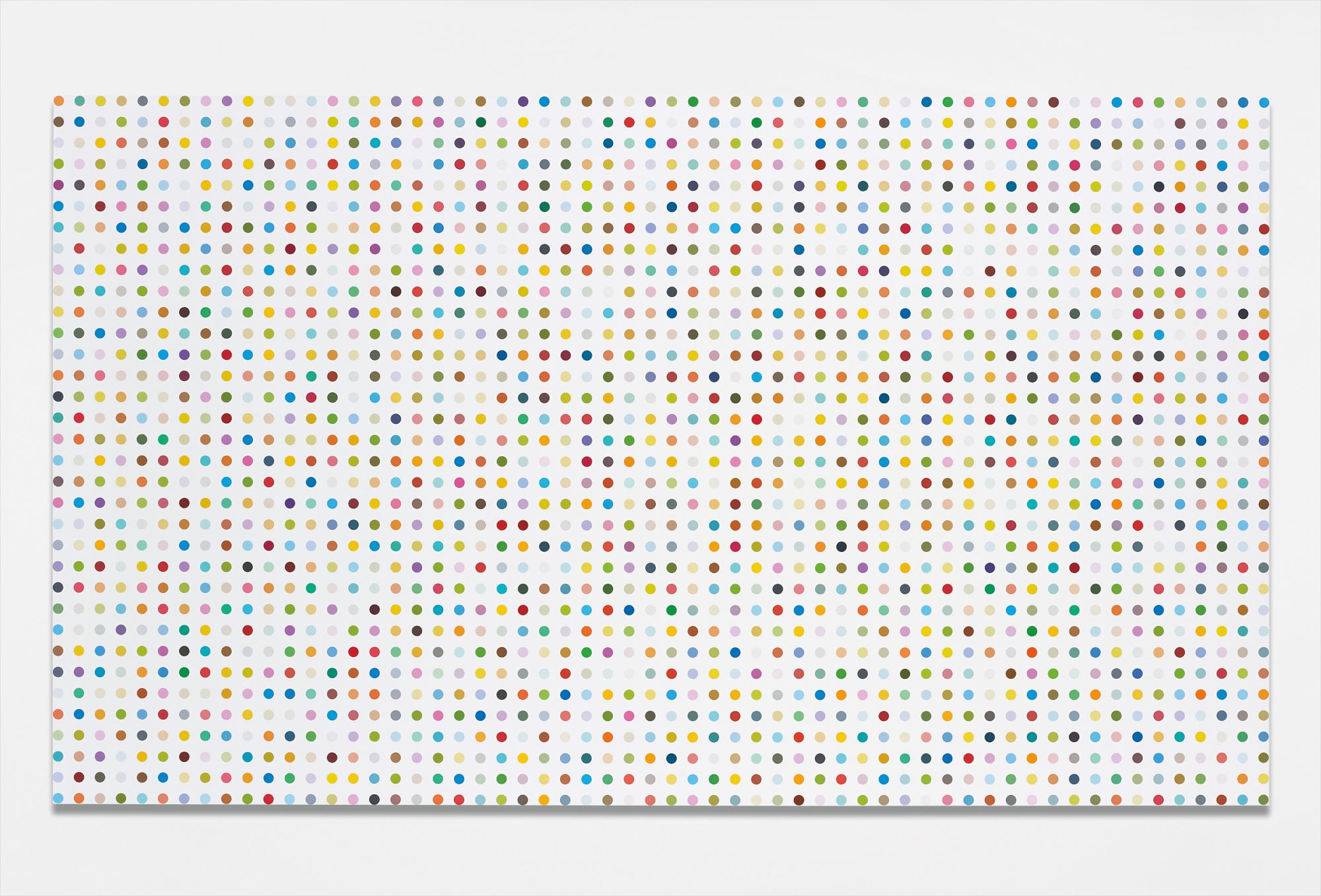

27
Damien Hirst
5-Fluorotryptamine
Full-Cataloguing
5-Fluorotryptamine, on a superficial level is playful in quality with its multi-coloured dots, but upon closer observation, one realises the subversive subject matter underpinned by the chemical compound title. The work serves as a critique of our dependency as an over medicated society and the unregulated dispersal of pharmaceutical prescriptions. 5-Fluorotryptamine’s visual pleasure rises out of the several hundred uniquely coloured spots that are arranged in a geometric grid, equidistant from one another. The pattern implies order, but when inspecting the colours closely, one realises that no two spots are the same pigment, instead each differs slightly creating a effect that generates an underlying sensation of chaos. 'If you look closely at one of these paintings a strange thing happens: because of the lack of repeated colours there is no harmony. We are used to picking out chords of the same colour and balancing them with different chords of other colours to create meaning. This can’t happen. So in every painting there is subliminal sense of unease; yet the colours project so much joy it’s hard to feel it, but it’s there.' (D. Hirst, i want to spend the rest of my life everywhere, with everyone, one to one, always, forever, now, London, 1997, p. 246)
With wall-power which commands immediate attention, the large number of spots trick the eye and make it difficult to focus on one specific colour. Each circle is arranged in carefully measured rows and columns in which the spectator’s eyes begin to unfold systematic patterns and grids - jumping from bright to dark, the eye is never forced to remain at one focal point. This gives the sense that the painting appears to be computer generated- masking the artistic hand behind its machine-like quality. Hirst elaborates, 'I like the way the paintings look like they could have been made by a big machine – the machine being the artist in the future.' (D. Hirst, i want to spend the rest of my life everywhere, with everyone, one to one, always, forever, now, London, 1997, p. 246)
5-Fluorotryptamine forms part of an endless series of paintings. The various possibilities of coloured spot combinations on Hirst’s canvases metaphorically stand for the infinite chemical compounds that exist in the medical field – echoed in the arbitrary titles sourced by the artist from the chemical company Sigma-Aldrich’s catalogue ‘Biochemicals for Research and Diagnostic Reagents’. Hirst describes the series as, 'a scientific approach to painting in a similar way to the drug companies’ scientific approach to life...' (D. Hirst, i want to spend the rest of my life everywhere, with everyone, one to one, always, forever, now, London, 1997, p. 246)
Prior to, and during the same period that Hirst was creating his spot paintings, he was developing another unique body of work closely related to the subject of pharmacology - his medicine cabinet series. Hirst’s medicine cabinets, each stocked with prescription drugs, appear as if they were taken directly out of a pharmacy, untouched in preparation for exhibition. It is evident that the installation of the drugs in each of his medicine cabinets helped lay the foundation for Hirst’s compositional constructions and his close attention to order, as reiterated in the present lot. Indeed, this orderly composition of structure is visible in wide variety of works, such as the cigarette butts organised on shelves, the cast hand-painted pills in stainless steel cabinets and the dead butterflies placed on canvas - each formally arranged giving a sense of intricacy. Each individual object, whether it is the cigarette, the pill, or the spot, acts as an accessory to the greater composition, therefore rendering them totally equal as completely essential elements to the work they created. 5-Fluorotryptamine serves as a powerful example of the formal arrangements used by the artist – employing serial repetition, specific ordering and the balance of colour as all crucial in the work’s projection. Hirst’s unique ability to gradually subvert, condense, package, order and re-present the weighty topics of life and death, science and medicine, consumption and abuse is epitomised in this series of paintings that have continually been produced over the last two decades. Creating a dynamic painting filled with a combination of visual playfulness, semiotic elements and conceptual significance, Hirst produces work that touches on deep emotions through his ingeniously simple artistic vision.
Damien Hirst
British | 1965There is no other contemporary artist as maverick to the art market as Damien Hirst. Foremost among the Young British Artists (YBAs), a group of provocative artists who graduated from Goldsmiths, University of London in the late 1980s, Hirst ascended to stardom by making objects that shocked and appalled, and that possessed conceptual depth in both profound and prankish ways.
Regarded as Britain's most notorious living artist, Hirst has studded human skulls in diamonds and submerged sharks, sheep and other dead animals in custom vitrines of formaldehyde. In tandem with Cheyenne Westphal, former Chairman of Phillips, Hirst controversially staged an entire exhibition directly for auction with 2008's "Beautiful Inside My Head Forever," which collectively totalled £111 million ($198 million).
Hirst remains genre-defying and creates everything from sculpture, prints, works on paper and paintings to installation and objects. Another of his most celebrated series, the 'Pill Cabinets' present rows of intricate pills, cast individually in metal, plaster and resin, in sterilized glass and steel containers; Phillips New York showed the largest of these pieces ever exhibited in the United States, The Void, 2000, in May 2017.